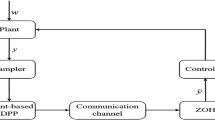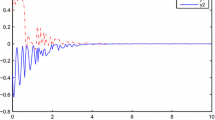Abstract
This paper investigates the hidden Markov model-based finite-time synchronization problem for discrete-time fuzzy jumping neural networks with input constraints. To cope with the fact that obtaining system mode information is difficult normally, a general case when either transition probabilities or observation probabilities of jumping processes are assumed to be partially known is taken into account. Furthermore, the input constraints which may lead to the failure of the presented designed method are also considered. Based on this, a finite-time synchronization criterion is established by using the observation signal, and an effective control scheme with less conservatism is given with the help of the activation function division method and hidden Markov model-based method. Finally, an example is used to demonstrate the effectiveness of the proposed method.






Similar content being viewed by others
References
Ali MS, Balasubramaniam P (2009) Exponential stability of uncertain stochastic fuzzy BAM neural networks with time-varying delays. Neurocomputing 72(4–6):1347–1354
Ali MS, Saravanakumar R, Ahn CK et al (2017) Stochastic \(H_{\infty }\) filtering for neural networks with leakage delay and mixed time-varying delays. Inf Sci 388:118–134
Ali MS, Vadivel R, Alsaedi A et al (2020) Extended dissipativity and event-triggered synchronization for T-S fuzzy Markovian jumping delayed stochastic neural networks with leakage delays via fault-tolerant control. Soft Comput 24(5):3675–3694
Balasubramaniam P, Ali MS (2010) Robust stability of uncertain fuzzy cellular neural networks with time-varying delays and reaction diffusion terms. Neurocomputing 74(1–3):439–446
Bao G, Wen S, Zeng Z (2012) Robust stability analysis of interval fuzzy Cohen-Grossberg neural networks with piecewise constant argument of generalized type. Neural Netw 33:32–41
Blümke O (2022) A structural hidden Markov model for forecasting scenario probabilities for portfolio loan loss provisions. Knowl-Based Syst 249(108):934
Chandrasekar A, Rakkiyappan R, Li X (2016) Effects of bounded and unbounded leakage time-varying delays in memristor-based recurrent neural networks with different memductance functions. Neurocomputing 202:67–83
Chandrasekar A, Radhika T, Zhu Q (2022) State estimation for genetic regulatory networks with two delay components by using second-order reciprocally convex approach. Neural Process Lett 54(1):327–345
Cheng J, Ahn CK, Karimi HR et al (2019) An event-based asynchronous approach to Markov jump systems with hidden mode detections and missing measurements. IEEE Trans Syst Man Cybern Syst 49(9):1749–1758
Dai J, Tan P, Yang X et al (2022) A fuzzy adaptive zeroing neural network with superior finite-time convergence for solving time-variant linear matrix equations. Knowl-Based Syst 242:108405
Gundu V, Simon SP (2021) Short term solar power and temperature forecast using recurrent neural networks. Neural Process Lett 53(6):4407–4418
Kamenkov G (1953) On stability of motion over a finite interval of time. J Appl Math Mech 17(2):529–540
Kao Y, Wang C, Zhang L (2013) Delay-dependent robust exponential stability of impulsive Markovian jumping reaction-diffusion Cohen-Grossberg neural networks. Neural Process Lett 38(3):321–346
Kapil P, Ekbal A (2020) A deep neural network based multi-task learning approach to hate speech detection. Knowl-Based Syst 210(106):458
Kasabov N, Dhoble K, Nuntalid N et al (2013) Dynamic evolving spiking neural networks for on-line spatio-and spectro-temporal pattern recognition. Neural Netw 41:188–201
Li F, Song S, Zhao J et al (2019) Synchronization control for Markov jump neural networks subject to HMM observation and partially known detection probabilities. Appl Math Comput 360:1–13
Li F, Xu S, Zhang B (2020) Resilient asynchronous \(H_{\infty }\) control for discrete-time Markov jump singularly perturbed systems based on hidden Markov model. IEEE Trans Syst Man Cybern Syst 50(8):2860–2869
Li F, Zhao J, Song S et al (2020) \(H_{\infty }\) filtering for Markov jump neural networks subject to hidden-Markov mode observation and packet dropouts via an improved activation function dividing method. Neural Process Lett 51(2):1939–1955
Li Z, Chen Z, Fang T et al (2023) Extended dissipativity-based synchronization of Markov jump neural networks subject to partially known transition and mode detection information. Neurocomputing 517:201–212
Lu Y, Yang D, Li Z et al (2022) Neural networks with upper and lower bound constraints and its application on industrial soft sensing modeling with missing values. Knowl-Based Syst 243:108510
Moghadam SM, Seyyedsalehi SA (2018) Nonlinear analysis and synthesis of video images using deep dynamic bottleneck neural networks for face recognition. Neural Netw 105:304–315
Perikos I, Kardakis S, Hatzilygeroudis I (2021) Sentiment analysis using novel and interpretable architectures of hidden Markov models. Knowl-Based Syst 229(107):332
San Filippo FA, Dorato P (1974) Short-time parameter optimization with flight control application. Automatica 10(4):425–430
Shambour Q (2021) A deep learning based algorithm for multi-criteria recommender systems. Knowl-Based Syst 211(106):545
Shen H, Hu X, Wang J et al (2021) Non-fragile \(H_{\infty }\) synchronization for Markov jump singularly perturbed coupled neural networks subject to double-layer switching regulation. IEEE Trans Neural Netw Learn Syst. https://doi.org/10.1109/TNNLS.2021.3107607
Shen H, Xing M, Yan H et al (2022) Observer-based \(l_{2}\)-\(l_{\infty }\) control for singularly perturbed semi-Markov jump systems with improved weighted TOD protocol. Sci China Inf Sci 65(9):1–2
Shen Y, Wu ZG, Shi P et al (2018) Asynchronous filtering for Markov jump neural networks with quantized outputs. IEEE Trans Syst Man Cybern Syst 49(2):433–443
Shi H, Qin C, Xiao D et al (2020) Automated heartbeat classification based on deep neural network with multiple input layers. Knowl-Based Syst 188(105):036
Song J, Niu Y, Zou Y (2017) Asynchronous output feedback control of time-varying Markovian jump systems within a finite-time interval. J Frankl Inst 354(15):6747–6765
Sun C, He W, Hong J (2017) Neural network control of a flexible robotic manipulator using the lumped spring-mass model. IEEE Trans Syst Man Cybern Syst 47(8):1863–1874
Tamil Thendral M, Ganesh Babu TR, Chandrasekar A et al (2022) Synchronization of Markovian jump neural networks for sampled data control systems with additive delay components: Analysis of image encryption technique. Math Methods Appl Sci. https://doi.org/10.1002/mma.8774
Tian Y, Wang Z (2021) Extended dissipativity analysis for Markovian jump neural networks via double-integral-based delay-product-type Lyapunov functional. IEEE Trans Neural Netw Learn Syst 32(7):3240–3246
Tong D, Zhu Q, Zhou W et al (2013) Adaptive synchronization for stochastic T-S fuzzy neural networks with time-delay and Markovian jumping parameters. Neurocomputing 117:91–97
Tuan HD, Apkarian P, Narikiyo T et al (2001) Parameterized linear matrix inequality techniques in fuzzy control system design. IEEE Trans Fuzzy Syst 9(2):324–332
Wang J, Ji Z, Zhang H et al (2021) Synchronization of generally uncertain Markovian inertial neural networks with random connection weight strengths and image encryption application. IEEE Trans Neural Netw Learn Syst. https://doi.org/10.1109/TNNLS.2021.3131512
Wang J, Yang C, Xia J et al (2022) Observer-based sliding mode control for networked fuzzy singularly perturbed systems under weighted try-once-discard protocol. IEEE Trans Fuzzy Syst 30(6):1889–1899
Wang L, Zeng K, Hu C et al (2022) Multiple finite-time synchronization of delayed inertial neural networks via a unified control scheme. Knowl-Based Syst 236(107):785
Wang S, Xiang J, Zhong Y et al (2018) Convolutional neural network-based hidden Markov models for rolling element bearing fault identification. Knowl-Based Syst 144:65–76
Wei F, Chen G, Wang W (2021) Finite-time stabilization of memristor-based inertial neural networks with time-varying delays combined with interval matrix method. Knowl-Based Syst 230(107):395
Wen S, Zeng Z, Huang T et al (2014) Exponential adaptive lag synchronization of memristive neural networks via fuzzy method and applications in pseudorandom number generators. IEEE Trans Fuzzy Syst 22(6):1704–1713
Wen S, Huang T, Zeng Z (2015) Circuit design and exponential stabilization of memristive neural networks. Neural Netw 63:48–56
Wen S, Zeng Z, Huang T et al (2015) Lag synchronization of switched neural networks via neural activation function and applications in image encryption. IEEE Trans Neural Netw Learn Syst 26(7):1493–1502
Xia W, Xu S, Lu J et al (2020) Reliable filter design for discrete-time neural networks with Markovian jumping parameters and time-varying delay. J Frankl Inst 357(5):2892–2915
Xiao J, Zeng Z, Wu A et al (2020) Fixed-time synchronization of delayed Cohen-Grossberg neural networks based on a novel sliding mode. Neural Netw 128:1–12
Xu N, Sun L (2019) Synchronization control of Markov jump neural networks with mixed time-varying delay and parameter uncertain based on sample point controller. Nonlinear Dyn 98(3):1877–1890
Yin R, Li K, Zhang G et al (2019) A deeper graph neural network for recommender systems. Knowl-Based Syst 185(105):020
Zhang L, Wang S, Karimi HR et al (2015) Robust finite-time control of switched linear systems and application to a class of servomechanism systems. IEEE/ASME Trans Mech 20(5):2476–2485
Zhou L (2015) Delay-dependent exponential synchronization of recurrent neural networks with multiple proportional delays. Neural Process Lett 42(3):619–632
Zhu Q, Cao J, Hayat T et al (2015) Robust stability of Markovian jump stochastic neural networks with time delays in the leakage terms. Neural Process Lett 41(1):1–27
Author information
Authors and Affiliations
Contributions
ZL and YC: Conceptualization, Methodology, Software. LS: Writing-Original draft preparation. KS: Validation, Supervision. HS: Funding acquisition. All authors reviewed the manuscript
Corresponding author
Ethics declarations
Conflict of interest
The authors declare that they have no conflict of interest.
Additional information
Publisher's Note
Springer Nature remains neutral with regard to jurisdictional claims in published maps and institutional affiliations.
The Natural Science Foundation for Distinguished Young Scholars of Higher Education Institutions of Anhui Province under grant 2022AH020034, the Natural Science Foundation of Anhui Province under Grants 2108085QF276, the Natural Science Foundation for Excellent Young Scholars of Higher Education Institutions of Anhui Province under grant 2022AH030049, the Major Natural Science Foundation of Higher Education Institutions of Anhui Province under grant KJ2020ZD28, Natural Science Foundation for Excellent Young Scholars of Anhui Province 2108085Y21, the Major Technologies Research and Development Special Program of Anhui Province under Grant 202003a05020001, the Key research and development projects of Anhui Province under Grant 202104a05020015, the Open Project of China International Science and Technology Cooperation Base on Intelligent Equipment Manufacturing in Special Service Environment under Grant ISTC2021KF04.
Rights and permissions
Springer Nature or its licensor (e.g. a society or other partner) holds exclusive rights to this article under a publishing agreement with the author(s) or other rightsholder(s); author self-archiving of the accepted manuscript version of this article is solely governed by the terms of such publishing agreement and applicable law.
About this article
Cite this article
Li, Z., Cai, Y., Su, L. et al. HMM-based finite-time synchronization of fuzzy jumping neural networks with input constraints and partial information. Neural Process Lett 55, 9699–9720 (2023). https://doi.org/10.1007/s11063-023-11222-3
Accepted:
Published:
Issue Date:
DOI: https://doi.org/10.1007/s11063-023-11222-3




